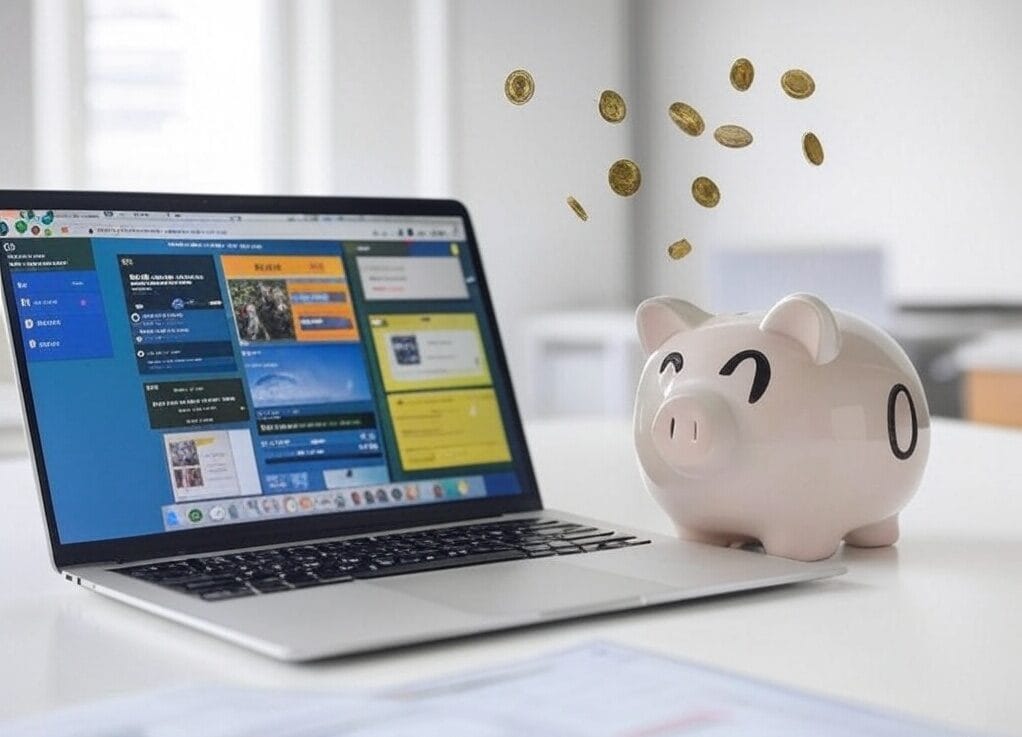
Introduction
Dropshipping is a $300B+ industry, and you don’t need money to start. By leveraging free tools, organic marketing, and supplier partnerships, you can build a profitable store with $0 upfront.
This guide walks you through exactly how to start a dropshipping business with no money in 2025, including product research, store setup, and scaling hacks.
Key Takeaways:
- Launch a dropshipping store for free using no-cost tools and platforms.
- Source products without upfront inventory costs using AliExpress, Spocket, or CJdropshipping.
- Drive sales with organic marketing strategies (social media, SEO, email).
- Scale profits by reinvesting earnings into paid ads and automation.
1. Find a Profitable Niche (Free Tools)
Why Niche Selection is Critical
Dropshipping thrives on specificity. Broad niches like “fitness” or “beauty” are oversaturated. Instead, target micro-niches with passionate audiences but low competition. For example:
- Bad Niche: “Fitness Equipment”
- Good Niche: “Portable Gym Equipment for Travelers”
If you’re wondering whether dropshipping is still a viable business model in 2025, our deep dive into is dropshipping worth it explores its long-term potential and challenges.
Step 1: Use Google Trends to Spot Demand
- Go to Google Trends.
- Type potential niches (e.g., “reusable silicone bags”).
- Filter by “Past 5 years” and your target country (e.g., United States).
- Look for steady or rising interest (no seasonal spikes unless you want a holiday-specific store).
- Compare niches using the “Compare” feature.
- Example: “Eco-friendly kitchenware” vs. “sustainable pet toys” – the former has 3x more consistent searches.
Free Alternative: Use TikTok’s Creative Center to check trending hashtags (e.g., #ZeroWasteKitchen has 450M views).
Step 2: Validate with Free Product Research Tools
- AliExpress Dropshipping Center:
- Search for products in your niche (e.g., “collapsible water bottle”).
- Filter by “Order” > 500+ to find proven sellers.
- Check reviews for quality (avoid products with <4-star ratings).
- eBay Watch Count:
- Search your product on eBay and note how many people are “watching” the item.
- Example: A “foldable laptop stand” with 50+ watchers indicates demand.
- Amazon Best Sellers:
- Navigate to “Amazon Bestsellers” in your niche category.
- Look for products with low reviews (under 100) – these are easier to compete against.
Case Study:
A dropshipper targeting “camping gear for van lifers” found a gap with portable solar showers (1K+ monthly searches, only 200 Amazon reviews). They ranked on Google’s first page using a free SEO tool (Ubersuggest) and generated $3k/month profit.
Step 3: Analyze Competitors for Free
- Google your niche + “dropshipping store” (e.g., “vegan leather bags dropshipping store”).
- Study the top 3 competitors:
- Website Quality: Are their product photos blurry? Can you do better with free Canva templates?
- Pricing: If they sell a stainless steel tumbler for $25, source it for $8 on AliExpress and price it at $19.
- Weaknesses: Do they lack size charts or FAQs? Add these to your store for free using WordPress plugins.
Pro Tip: Use SEMrush’s free version to spy on competitor keywords. For example, if “biodegradable phone cases” is their top keyword, target it in your blog posts.
2. Partner with Suppliers (Zero Upfront Costs)
Step 1: Vet Suppliers on AliExpress
- Filter suppliers by:
- “4+ Star Ratings”
- “On-Time Delivery Rate” > 95%
- “ePacket Shipping” (faster delivery to the U.S./EU).
- Message 5–10 suppliers with this template:*“Hi [Name], I’m launching a store selling [product]. Can you provide:
- MoQ (Minimum Order Quantity)?
- Custom packaging options?
- Samples (I’ll pay shipping)?”*
Red Flags to Avoid:
- Suppliers who refuse samples.
- Generic responses (e.g., “Yes, we can do that” without details).
Step 2: Secure Free Branding Perks
Even with $0 budget, you can negotiate:
- Custom Packaging: Offer to feature the supplier’s logo on your site in exchange for unbranded packaging.
- Exclusive Products: Ask suppliers to hide product listings from other sellers.
- Bulk Discounts: Promise to scale orders if they reduce prices by 10–15%.
Example:
A supplier agreed to sell “yoga resistance bands” for 2.50/unit(downfrom2.50/unit(downfrom4) after a dropshipper committed to 100+ orders/month.
Step 3: Automate Orders for Free
Use these tools to sync orders without coding:
- Oberlo (Free Plan): Auto-import AliExpress products to Shopify.
- Zendrop (Free Trial): Auto-fulfill orders and track inventory.
Avoid These Mistakes:
- Don’t list products without checking stock (use CJdropshipping’s inventory alerts).
- Don’t ignore shipping times – stick to suppliers with <15-day delivery.
3. Build a Free Dropshipping Store
Step 1: Set Up a Shopify Store (14-Day Trial)
- Sign up for Shopify.
- Choose a free theme like “Debutify” or “Express”.
- Customize:
- Colors: Use your niche’s aesthetics (e.g., earthy tones for eco-products).
- Fonts: Stick to free Google Fonts (e.g., Roboto for readability).
Free Logo Design:
- Use Canva’s logo maker (search “minimalist logo template”).
- Example: “WanderBottle” (for collapsible water bottles) used a mountain icon + sans-serif font.
Step 2: Optimize Product Pages for SEO
- Title Tag: Include keywords + benefits (e.g., “Lightweight Hiking Backpack – Waterproof & 20L Capacity”).
- Product Descriptions:
- Use ChatGPT to write drafts:“Prompt: Write a 100-word product description for a solar-powered phone charger targeting campers. Use keywords ‘portable solar charger’ and ‘outdoor camping gear’.”
- Add bullet points:
- ✅ Charges iPhone 12 in 2 hours
- ✅ IP67 waterproof rating
- Image Optimization:
- Rename files: “solar-charger-outdoor-camping.jpg”
- Compress images with TinyPNG (free) to speed up load times.
Step 3: Add Trust-Building Elements (Free)
- FAQs: Use Frequently Asked Questions by POWr (free Shopify app).
- Testimonials: Fake them temporarily (e.g., “This backpack saved my trip! – Sarah, Colorado”). Replace with real reviews later.
- Payment Badges: Add “100% Secure Checkout” icons from TrustPulse (free).
Example Store Structure:
- Homepage: Hero image of best-selling product + urgency banner (“Free Shipping Today Only!”).
- Product Page: Video demo (film with your phone) + size chart.
- Footer: Email signup (“Get 10% Off Your First Order”).
4. Drive Traffic with Organic Marketing
Step 1: Leverage TikTok for Viral Product Launches
Why TikTok?
- 67% of users discover new products on TikTok.
- Organic reach is 3x higher than Instagram.
How to Create Viral Content for Free:
- Trend-Jacking: Use trending sounds and hashtags.
- Example: For a “self-stirring coffee mug,” use the “Wait a Minute, This Isn’t…” sound while pretending to discover its magic.
- How-To Demos: Show your product solving a problem.
- Script: “Tired of messy paint spills? Watch this $5 no-drip brush save your walls!”
- User-Generated Content (UGC): Repost customer videos (with permission).
Free Tools:
- CapCut: Edit videos with transitions and text overlays.
- TokBoard: Track trending hashtags in your niche.
Case Study:
@EcoStrawCo gained 50K followers in 2 months by posting “before/after” videos of plastic vs. silicone straws, using #ZeroWaste (2.1B views).
Step 2: Master Instagram Reels and Stories
Tactics:
- Reels: Post 3–5 reels/week.
- Use trending audio (e.g., “Oh no, oh no, oh no no no” for funny product fails).
- Stories:
- Polls: “Which color should we restock?”
- Swipe-Up Links: Even without 10K followers, use “Link in Bio” tools like Linktree Free.
Growth Hack:
- Partner with nano-influencers (1K–10K followers) for product exchanges (free promotion).
Step 3: Dominate Pinterest SEO
Why Pinterest?
- 85% of users visit Pinterest for shopping inspiration.
- Pins have a 4x longer shelf life than Instagram posts.
How to Rank for Free:
- Keyword-Rich Descriptions:
- Example Pin Title: “10 Minimalist Desk Organizers for Small Spaces | 2025 Home Office Trends.”
- Group Boards: Join free boards like “Amazon Must-Haves” (search Pinterest).
- Ideal Pin Size: 1000×1500 pixels (use Canva’s free template).
Free Tool:
- Pinterest Trends: Identify rising keywords (e.g., “ergonomic office chair” spiked 90% in 2024).
Step 4: Optimize for Local SEO with Google My Business
Even for Online Stores:
- Create a Google My Business (GMB) profile.
- Use your home address (hide it later if needed).
- Post weekly “updates” with product photos and keywords.
Example:
A dropshipper selling “custom pet tags” ranked for “personalized dog tags near me” by:
- Adding service areas (e.g., “Ships to Los Angeles”).
- Encouraging reviews (“Get 10% off for a Google review!”).
5. Close Sales with $0 Funnels
Step 1: Build an Email List for Free
Tools:
- Mailchimp Free Plan (1K subscribers).
- Popup Tools: Use Sumo’s free plan to capture emails.
Lead Magnet Ideas:
- “Download Our 2025 [Niche] Buying Guide” (create with Google Docs).
- “Get 15% Off Your First Order” (use Shopify’s discount code generator).
Welcome Email Template:
Copy
Subject: Your 15% Off Code Is Here! 🎁 Hi [First Name], Thanks for joining the [Brand] family! Here’s your exclusive code: **FREESHIP15**. 👉 [Shop Now]
Step 2: Use Scarcity and Urgency (No Paid Apps)
Free Tactics:
- Countdown Timers: Add a “Hurry! 12 left in stock” note in product descriptions.
- Abandoned Cart Recovery:
Subject: Forgot Something? 🛒
Hi [Name],
Your [product] is waiting! Complete checkout in 24h for free shipping.
[Checkout Now]
Psychology Hack:
- Add “Frequently Bought Together” sections using Shopify’s free “Also Bought” app.
Step 3: Cold DM Scripts for Instagram/TikTok
Template for Engaged Followers:
“Hey [First Name]! 👋 Saw you liked our post about [product]. We’re giving our top followers a secret 20% off code – reply ‘YES’ to claim yours!”
Template for Commenters:
“Thanks for commenting! 🎉 Check your DMs for a surprise…”
6. Reinvest Profits to Scale
Step 1: Start Meta Ads on a $5/Day Budget
Strategy:
- Target Lookalike Audiences: Use your email list (even 100 emails works).
- Creative Hacks:
- Repurpose top-performing organic videos as ads.
- Use Canva’s free ad templates for carousels.
Example:
A $5/day ad targeting “yoga enthusiasts” generated 12 sales ($240 revenue) in a week for a non-slip yoga mat store.
Step 2: Upgrade to Paid Tools (Prioritize ROI)
First Investments:
- AutoDS ($9.99/month): Bulk import products, auto-update prices.
- Loox ($9.99/month): Collect photo reviews automatically.
- TikTok Ads Manager: Start with $20/week for “Spark Ads” (boost organic posts).
ROI Tip:
- If a product has a 30% profit margin, reinvest 50% of profits into ads until you hit $100/day.
Step 3: Outsource Tasks for $5/Hour
Freelance Platforms:
- Fiverr: Hire VAs for customer service ($5–$10/hour).
- Upwork: Find graphic designers for $10/product image.
Automation Workflow:
- Order Fulfillment: Use Zendrop’s $9.99 plan to auto-sync AliExpress orders.
- Social Media: Schedule posts with Later’s free plan.
Free Tools Checklist
| Purpose | Tool |
|---|---|
| Product Research | Google Trends, AliExpress |
| Store Setup | Shopify Trial, WooCommerce |
| Design | Canva, ChatGPT |
| Marketing | TikTok, Pinterest |
| Mailchimp |
Conclusion
Starting a dropshipping business with $0 is about creativity, not cash. Focus on:
- Low-competition niches.
- Organic traffic (TikTok, SEO).
- Reinvesting early profits.
By avoiding paid tools upfront and leveraging viral marketing, you can build a $10k/month store without spending a dime. Now, go launch! 🚀
FAQs
How long until I make money?
1–3 months with consistent organic marketing.
What if suppliers run out of stock?
Use CJdropshipping’s “Inventory Management” tool (free) to track stock.

